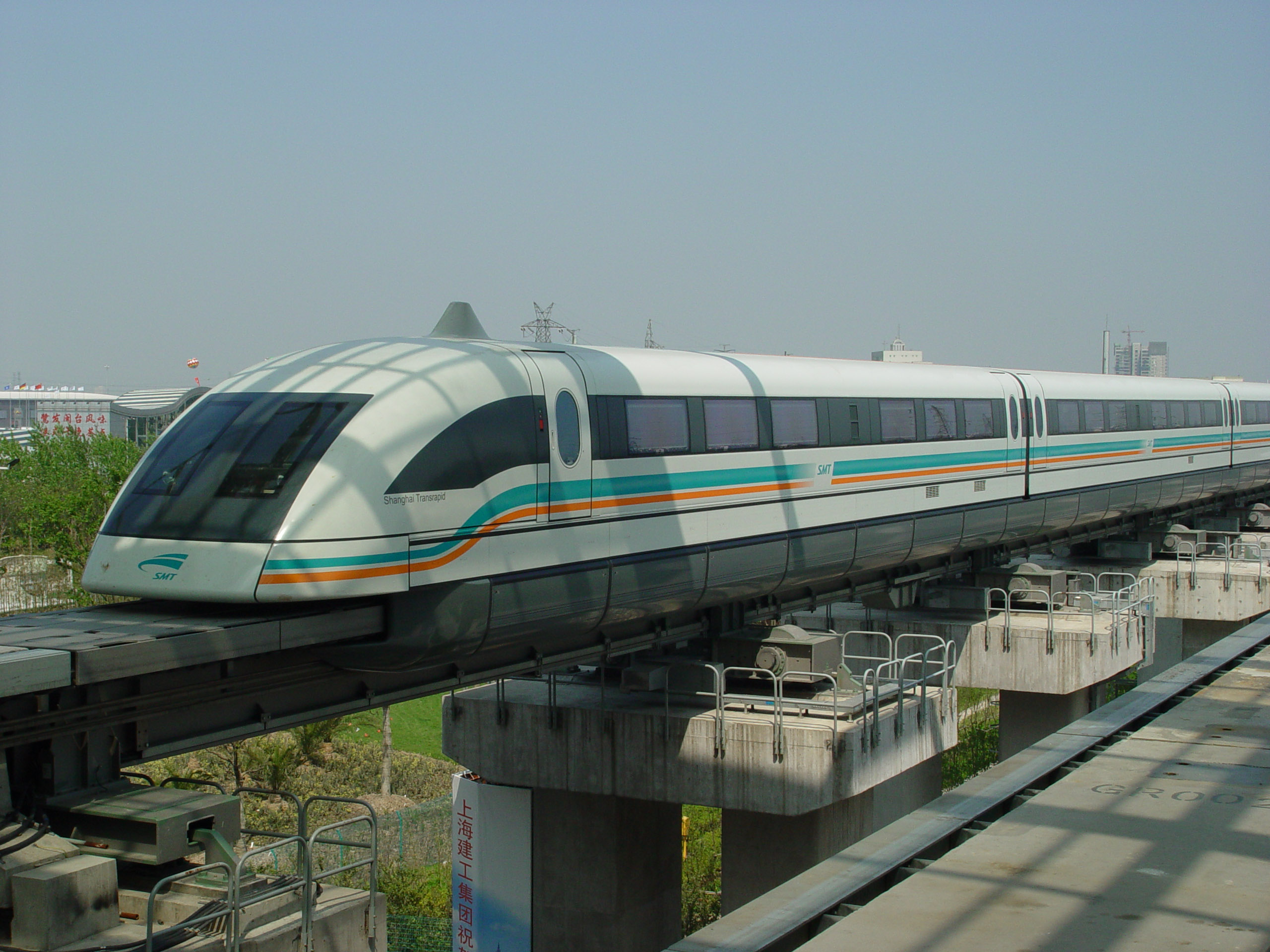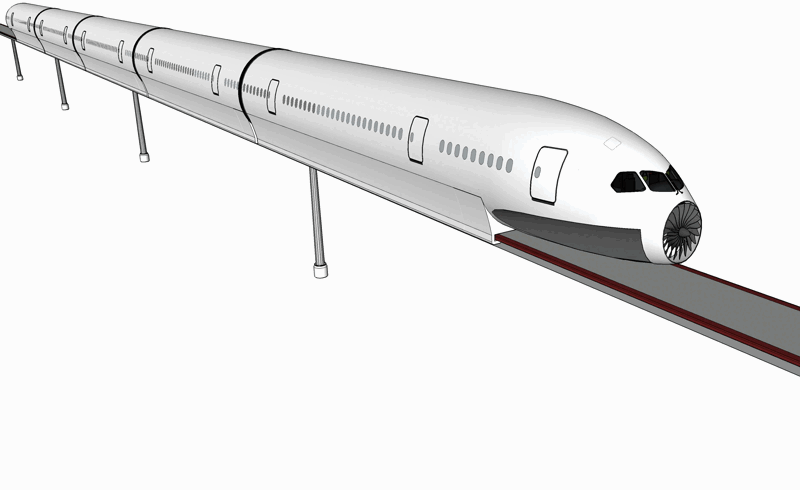
Around 2010, I flew to Shanghai from Manchester, UK, to attend a scientic conference. After touching down at the Shanghai airport, I stepped inside what I assumed was the usual train to the city. At the appointed time, the train started moving. I could see that because the building and people outside the window were sliding backwards. But to my surprise, I could not feel any motion at all. There was none of the usual jerks and tremors I would get on the trains in the UK, or the MRT (underground train) in Singapore. If I had not look out of the window, I would have no idea I was moving.
And then I looked out of the window. I was shocked - the horizon had tilted upwards by almost 30 degrees. The train was going to fall off the rail! But I did not feel any force pushing me to one side at all. It was a weird feeling. What was going on? And then I remembered my school physics. A centripetal force is needed for the train to go round a bend. At such speed, the centripetal force can be a significant fraction of my weight. Combined with gravity, the resultant force - at an angle to the vertical - became my effective weight. So even though my body was at this angle, I did not feel I was tilted - as there was no sideway force. As a result, while the train was rounding the bend, it gave the illusion that it was the ground that was tilted instead. (Kind of less fun when it was explained so logically.)
The Shanghai Maglev Train, also known as the Shanghai Transrapid, is a pioneering transportation system that represents a significant milestone in the development of high-speed rail technology. Operating since 2004, this maglev (magnetic levitation) train is one of the fastest commercial trains in the world, capable of reaching speeds of up to 431 km/h (268 mph). The train connects Shanghai Pudong International Airport with Longyang Road Station in downtown Shanghai, covering a distance of 30 kilometers (18.6 miles) in just about 7-8 minutes. This article delves into the physics behind maglev technology and the intricacies of the Shanghai Maglev Train's construction, examining the scientific principles, engineering challenges, and the vision behind this extraordinary transportation system.
1. Understanding Maglev Technology
Maglev trains operate on the principle of magnetic levitation, which involves using magnets to lift and propel the train, eliminating the need for conventional wheels and rails. This technology relies on the interplay of two primary magnetic forces: repulsion and attraction.
1.1 Magnetic Levitation
In a traditional train system, friction between the train's wheels and the track is a significant factor that limits speed and efficiency. In a maglev system, the train is suspended above the track using powerful magnetic fields, removing this friction. The levitation is achieved through electromagnetic forces (EMF), which use opposing magnetic fields to lift the train. Maglev trains are typically divided into two types based on how they achieve levitation:
Electrodynamic suspension (EDS): This system uses superconducting magnets to create a stable repulsive force between the train and the track.
Electromagnetic suspension (EMS): This system uses a combination of conventional electromagnets to create a lifting force.
In the case of the Shanghai Maglev, EMS technology is used, which involves using electromagnets on the train that interact with coils embedded in the track. These magnets are carefully controlled to maintain a stable air gap, typically about 10 millimeters, between the train and the track.
1.2 Magnetic Propulsion
Once the train is levitated, the next challenge is to move it forward at high speeds. This is achieved using linear synchronous motors (LSM), which are a form of electric motor that produces motion along a straight line, rather than rotating as in conventional motors. The LSM is placed along the track, and the train itself has an array of coils in the undercarriage.
When the current is passed through the coils in the track, it generates a changing magnetic field that induces a current in the train’s coils, creating a magnetic field in turn. This interaction between the two magnetic fields propels the train forward. By varying the current in the track’s coils, the train can be accelerated, decelerated, or maintained at a steady speed.
2. The Physics Behind Maglev Technology
This figure shows how the electromagnets on the rail tracks change poles repeatedly. As a result, the fixed magnetic poles under the train get both a levitating force and a forward force. The levitating force prevents any contact between train and rail, removing most of the friction. The forward force pushes the train ahead, and takes it where it wants to go.

At the core of the Shanghai Maglev's technology is the interaction of electromagnetism and motion. The key components that enable the levitation and propulsion of the train can be broken down into the following:
2.1 Lorentz Force
The movement of a charged particle in a magnetic field experiences a force known as the Lorentz force, which is essential in both the levitation and propulsion of maglev trains. When the current passes through the coils on the train, the magnetic field created by the track interacts with it, generating a force that propels the train. This electromagnetic interaction is what powers the train’s speed and efficiency.
2.2 Induced Currents and Lenz’s Law
As the magnetic fields change, induced currents are generated within the coils of the train and track, which act to oppose the change in magnetic flux. This phenomenon is governed by Lenz’s Law, which states that the direction of the induced current will always be such that it opposes the change that created it. The result is a highly efficient energy conversion process, where energy is continuously transferred to propel the train forward, with minimal energy losses.
2.3 Superconductivity and Efficiency
In some maglev systems, superconducting magnets are used, which are materials that, at very low temperatures, offer zero electrical resistance. This allows for extremely strong magnetic fields to be created without the wasteful energy dissipation associated with ordinary magnets. While the Shanghai Maglev Train does not use superconducting magnets, the concept of superconductivity plays a role in enhancing the efficiency and speed of maglev technology in other systems.
3. The Construction of the Shanghai Maglev
The Shanghai Maglev was built as part of a partnership between Germany’s Transrapid International and Chinese authorities, with the goal of creating a high-speed transportation link between the Pudong Airport and the city center. The project faced a range of engineering challenges, both in terms of the design of the train itself and the construction of the infrastructure required to support it.
3.1 Design and Engineering Challenges
Building a maglev train that could operate at such high speeds required cutting-edge technology and precise engineering. Unlike traditional rail systems, maglev trains require specially designed tracks, magnets, and electrical systems. The main challenges during the construction of the Shanghai Maglev were:
Track Design: The track had to be precisely aligned to ensure the train’s stability and safety at high speeds. Even small deviations could cause instability, leading to safety concerns. The track itself uses aluminum coils embedded in a concrete bed, and the precision required in laying these tracks was significant.
Magnetic Field Control: The magnetic fields needed to be controlled with an unprecedented level of accuracy. The system uses a complex series of magnets and sensors to maintain the levitation and propulsion of the train. These sensors ensure that the train maintains an optimal distance from the track, preventing it from colliding with or veering off the guideway.
Power Supply: Maglev trains require a substantial amount of power to generate the strong electromagnetic fields needed for levitation and propulsion. The system must have a consistent and reliable power supply, especially since power failures or fluctuations could lead to major safety issues.
Air Resistance and Aerodynamics: At speeds exceeding 400 km/h, air resistance becomes a major factor. The Shanghai Maglev’s design needed to minimize drag, which was achieved through aerodynamic shaping and advanced materials.
3.2 Construction Timeline and Milestones
The construction of the Shanghai Maglev Train began in 2001, and the project was completed in 2004. The timeline was ambitious, but the successful collaboration between Chinese engineers and their German counterparts resulted in the creation of the world’s first commercially operated high-speed maglev system. The route was carefully chosen to connect one of the world’s busiest airports with the bustling downtown area of Shanghai, ensuring both convenience and demand for the new system.
4. Impact of the Shanghai Maglev Train
The Shanghai Maglev Train has had a profound impact on both transportation and technology:
4.1 Speed and Efficiency
With its maximum speed of 431 km/h, the Shanghai Maglev Train revolutionized the concept of high-speed rail. The travel time from Pudong Airport to Longyang Road Station is just 7 minutes, far quicker than traditional means of transport, such as buses or conventional trains. This efficiency has made the train an attractive option for passengers, especially those with tight schedules.
4.2 Technological Innovation
The Shanghai Maglev has served as a testing ground for future maglev technologies. Many of the design principles and innovations developed for the Shanghai route have been adapted and refined for other projects around the world, with ongoing research focusing on improving speed, energy efficiency, and cost-effectiveness.
4.3 Economic Growth and Tourism
The train has contributed significantly to Shanghai’s economic growth by providing a fast, reliable transportation link that connects the airport with the city center. It has boosted tourism and business activity, making it easier for visitors and residents to travel quickly and comfortably.
5. Future of Maglev Trains
The Shanghai Maglev represents just the beginning of the potential for maglev transportation. With ongoing advancements in maglev technology, future systems may achieve even higher speeds, with some concepts aiming for speeds upwards of 600 km/h (373 mph). The expansion of maglev networks could revolutionize long-distance travel, reducing travel times between cities and even countries.
In addition to its speed, maglev trains are also seen as more environmentally friendly than traditional trains, as they generate less noise and produce fewer emissions. They offer a glimpse into a future of efficient, sustainable transportation systems.
Conclusion
The Shanghai Maglev Train stands as a testament to the possibilities of modern physics and engineering, combining the forces of electromagnetism with cutting-edge technology to create a high-speed transportation system that is both efficient and exhilarating. Its construction required innovative solutions to complex engineering challenges, while its operation showcases the immense potential of maglev technology in shaping the future of transportation. As the world continues to push the boundaries of what is possible in high-speed rail, the Shanghai Maglev remains a landmark achievement and a symbol of human ingenuity.

You can learn these concepts and more at Dr Hock's maths and physics tuition.